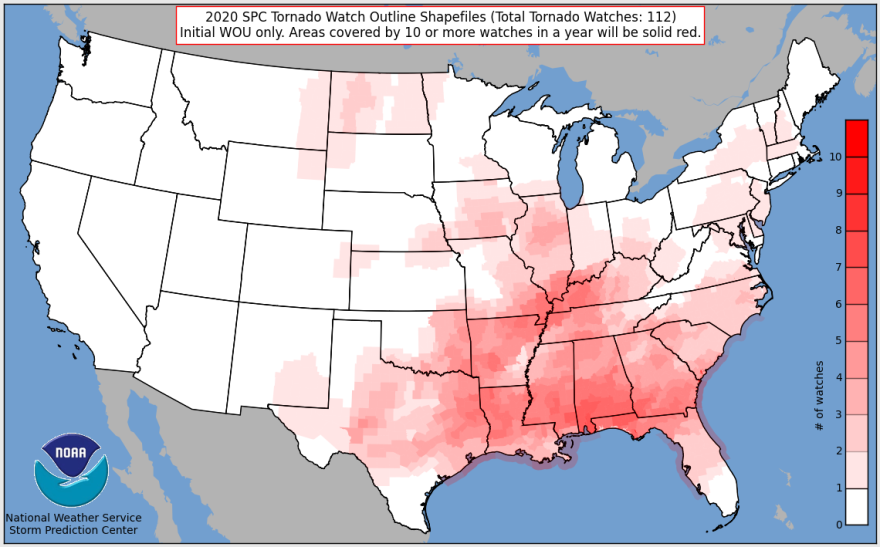WICHITA, Kansas — Tornadoes aren’t forming at the same pace as usual this year, creating one of Kansas’ quietest storm seasons in recent memory.
In fact, there hasn’t been a single documented tornado in any of the 26 counties served by the National Weather Service’s Wichita office.
Meteorologists warn that the past isn’t a good measure of the future — and considering weather experts still aren’t entirely sure how tornadoes form in the first place, understanding why one year is more active than another is a difficult task.
Tornadoes and severe weather can and do happen any time of the year in Kansas, but May tends to see the most action. Usually by this time of the year, the state has experienced the vast majority of tornadoes it will see; by July 2019, Kansas recorded 116 of its eventual total of 127.
This year, the number is much smaller: 24 recorded tornadoes through July 27.
“It’s quite impressive how slow this severe weather season is,” said Chance Hayes, a warning coordination meteorologist with the National Weather Service in Wichita.
To put that into some context, the NWS Wichita office’s territory extends from Russell County in north-central Kansas, down to the Kansas-Oklahoma border and east to Labette County.
In the first seven months of a given year, Hayes and his team issue an average of 213 severe weather warnings. This year, they’ve only issued 95. The next lowest number in the past decade was 154 in 2015.

Hayes said it’s hard to point to any one thing that is causing less severe weather. Storm systems are complex, and large year-to-year differences are normal.
On a very broad level, he said, the temperature of the Pacific Ocean is a contributing factor. It impacts how air in high altitudes moves across the globe. This year, the flow of air over Kansas has come mostly from the northwest.
“Typically when we see that northwest flow, most of the events that we receive are late evening or overnight,” Hayes said. “So, you don’t have a lot of the heat to drive the strength of the storms.”
In fact, the entire U.S. is seeing a below-average year when it comes to severe storms and tornadoes.

Through July 27, the National Weather Service Storm Prediction Center in Oklahoma counted 953 tornadoes, well below the average of 1,100.
Bill Bunting, chief of forecast operations at the Storm Prediction Center, said people often ask him if climate change impacts the number of severe storms in the U.S.
He doesn’t have a very good answer, he said.
Part of the problem is that, until the past 20-30 years, the only way to know if there was a tornado was for someone to see it. And scientists can’t assess long-term trends with much confidence due to incomplete data from previous years.
What they do know about how climate change impacts weather systems offers contradicting conclusions, he said. Some impacts of climate change make the conditions for severe weather more favorable, while other impacts decrease it.
“The net effect of changing climate on tornado frequency is one we really can’t answer conclusively at this point,” Bunting said.
He’s also noticed an increase in tornadic activity in the southeast part of the U.S., but believes it’s too early to say that Tornado Alley is shifting.

What he and other meteorologists do know is that the number of tornadoes each year is highly variable and rare, even in above-average years. Going back to 2005, the number of tornadoes in a given year has varied from a low of 943 to as high as 2,240.
Bunting also warned that it only takes one tornado in a highly populated area to cause millions of dollars in damage and mass casualties, which this year’s data bears out. The overall number of tornadoes is below average, but the number of deaths is already three times higher than the three-year average.
“If anyone thinks they can let their guard down living in the central U.S.,” he said, “that’s not the case.”
Brian Grimmett reports on the environment, energy and natural resources for KMUW in Wichita and the Kansas News Service. You can follow him on Twitter @briangrimmett or email him at grimmett (at) kmuw (dot) org. The Kansas News Service is a collaboration of KCUR, Kansas Public Radio, KMUW and High Plains Public Radio focused on health, the social determinants of health and their connection to public policy.
Kansas News Service stories and photos may be republished by news media at no cost with proper attribution and a link to ksnewsservice.org.






